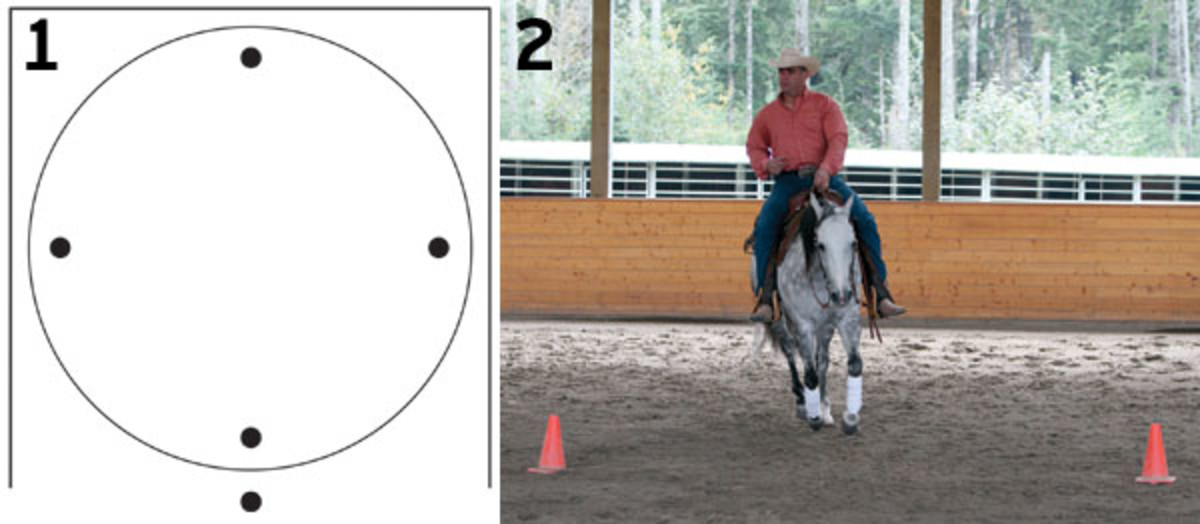When you can guide your horse on a perfectly symmetrical circle, you show a level of skill and focus that not all riders possess. That level of steering is essential in the show pen, but is also valuable for recreational riders. In both cases, it shows harmony and communication between horse and rider—and who doesn’t want that?
A lopsided or cutoff circle sets your horse up for trouble. Going too far out on one side means you’ll likely over-steer to get back on the path and dump his inside shoulder into the circle. That means he’s not traveling squarely between your reins and can’t carry himself properly. If you and your horse can lope a perfect circle, that means you’re both focused and in the right mindset to work on other things.
Here I’ll demonstrate an exercise that employs cones to help monitor your circle’s symmetry. You can complete the exercise at any gait, but I’m loping in these photos. Outfit your horse in whatever headgear you find him to be most responsive to your cues. Use only one end of the arena for this drill; and be sure to work in both directions.
1. Grab five cones (you can substitute gallon-size jugs of water), and set them up as shown in the diagram. Every arena is a rectangle, no matter its dimensions, and when you cut that rectangle in half, you get roughly two squares. The biggest circles you could travel in your arena lie within those squares, and that’s where you’ll set your cones. The proportions of your arena will affect the layout of your cones, but no matter the size of the space, the cones will be your guides for making perfect circles.

2. I’m loping squarely between the two cones placed in the middle of my arena. We’ll call this the bottom of the circle. Starting with proper placement in the arena here, I’ll be set up to reach each side of the circle in the right spot, making a perfectly symmetrical circle. As you can see, my eyes are up—I can see the cone in my peripheral vision, but I’m not staring straight at it. Instead, I’m looking toward the wall, keeping my round path of travel in mind.
3. Here’s a hind view of my horse’s placement between the cones and my own head and body position. As I approach the bottom of my circle and the cones, I almost aim for the cone on my left in this photo (the outside cone), just to keep from inadvertently cutting off my corner on the approach and letting my horse drop her shoulder. A slight over-exaggeration keeps us both on track and her front end upright and between my reins.

4. Compared to photos 1 and 2, you can see here that I’ve cut too close to the inside cone at the bottom of my circle. That means I let my horse drop her shoulder as I approached the middle. I’ll have to overcorrect to get my path back on track, not to mention get my horse back in frame and her shoulders square and upright.
5. As I continue along on my correct path around the circle, you can see that I keep my eyes up and looking ahead. Looking down at my horse’s poll, as many amateur riders get in the habit of doing, won’t help me stay on track. To stay symmetrical, I have to actively ride and look for my next spot.

6. I’m making my way around to the last cone before I’m back to center. You can see that my horse is set to be squarely in between the cone and the arena wall. This equidistant placement means I’ll be set up to approach the middle of my circle.
7. Conversely, here I’ve gotten off track. I’ve let my horse get too close to the wall by the final cone. You can see that I have to overcorrect to get her back on the right path. Doing so can cause her to drop her shoulder, which means she wouldn’t be set up for a lead change in the middle, if that were our next maneuver.

8. Sometimes, there’s not enough space between that last pass on the arena wall and the middle of the pen to get completely correct. Here, I’m still working to get her back on track, and we’re too close to the inner cone in the middle of the arena. This demonstrates that a few errant steps can throw off the entire circle. If I’d committed to ride every stride and pay attention to my path of travel, I wouldn’t have to worry about corrections. Furthermore, if we could complete a few symmetrical, correct circles, my horse and I would both be focused and ready to work on other maneuvers.
Darren Stancik trains reining horses from Sky River Equestrian Center in Sultan, Washington. Stancik is an AQHA world champion, an NRHA Futurity finalist, an NRHA judge, and a recognized pro at working with amateur riders. Learn more about him at stancik-qh.com.






